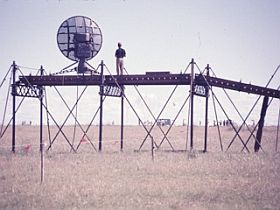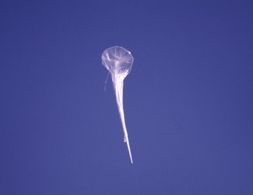Alegrete is a small town located in the western part of the Rio Grande do Sul state in southern Brasil. In 1966 the location was selected to perform a series of balloon launches, during a total sun eclipse that occured in November 12. The whole US eclipse operations in southamerica were under the coordination of the National Science Foundation, while the balloon experiments to be carried out at Alegrete were undertaken as a joint effort by Naval Ordnance Test Station, (China Lake, CA) which furnished the payload and managed the obtention of the data, the NCAR Scientific Balloon Facility wich managed the operations and provided the necessary ballooning support, and finally the University of Colorado commited to make the post-flight analysis and interpretation of the data obtained.

The purpose of the experiment was to measure the variations in atmospheric ozone resulting from changes in photo-chemical processes occurring during a total solar eclipse.
The operation began on the last days of October with the departure of the involved staff to Brazil. After resolving several problems with air shipments at Porto Alegre, the payloads, balloons and other elements arrived to planned launch site: the Alegrete airport. Between l and ll November the NCAR personel spent time setting up the base station, checking the equipment, and other preparatory work necessary for the proper operation of the project. At right we can see part of telemetry station mounted in one of the corners of the aerial station.
The first balloon launch was conducted on November 11, 1966, the previous day of the eclipse, to obtain background measurements of the atmospheric ozone content. Unfortunatelly, after a while, the signal from the balloon was lost as the payload was saturated of water when entering a the heavy rain shower. Final preparations of the eclipse flight were started soon after the failed flight, but according to the wind data obtained from the NCAR GMD, the launch was moved to the Uruguaina airport, located 130 km to the west near the Brazilian-Argentina border, to allow the predicted winds to move the balloon directly in the path of the eclipse's umbra.

The launch was made at 8:07 local time but due to strong surface winds (gusting to 25 knots) the balloon was pulled from the arms of the launch crew before proper removal of the restraining manual launch device, which provoked an early termination two hours later, just in the moment of the eclipse start.
Wind conditions were unfavorable for any flights on the next day but two more launches were made on 14 November from Alegrete, with similar results: both failed two hours after released when crossing the cold tropical tropopause. A final attempt to get an ozone instrument to the desired altitude was scheduled for 15 November, but was cancelled because of unfavorable wind and rain.
At that point as was difficult to foresee when weather conditions would be favorable, it was agreed to terminate the program. That was the only balloon launch campaign ever performed at the site.
Years later the airport was moved to the actual site being know as Aeroporto Alegrete Novo and being located 12 km SW of the city. Nowadays, the former location of the aerial station is being urbanized.
I wish to express my sincere gratitude to Dr. Arlin Krueger principal investigator of the Eclipse balloon project who kindly provided first hand accounts of the operation and searched for months among his files to locate the pictures showed here.
Table of balloons launched from Alegrete Airport, Rio Grande do Sul
| Date | Hour | Flight Duration | Experiment | Payload landing place or cause of the failure |
|---|---|---|---|---|
| 11/11/1966 | 2 h | STUDY OF OZONE VARIATION DURING ECLIPSE | --- No Data --- | |
| 11/14/1966 | 16:58 local | --- | STUDY OF OZONE VARIATION DURING ECLIPSE | --- No Data --- |
| 11/14/1966 | 18:29 local | --- | STUDY OF OZONE VARIATION DURING ECLIPSE | --- No Data --- |
If you consider this website interesting or useful, you can help me to keep it up and running with a small donation to cover the operational costs. Just the equivalent of the price of a cup of coffee helps a lot.

